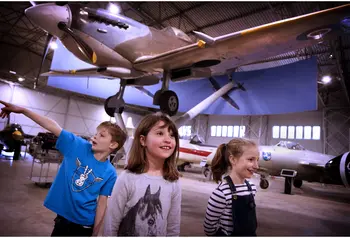Second World War hangars reopen thanks to National Lottery players

First built over 70 years ago, the hangars will open again today after a major redevelopment, thanks to a £1.3million grant from HLF, topped up to £3.6m by the Scottish government.
One hangar will display military aircraft, the other commercial and leisure aircraft. Uniforms, documents, photographs and weapons will also be on display alongside the aircraft for the first time.
- The military hangar will include highlights such as the oldest surviving Hawker Siddeley Harrier jump jet, which was the world’s first vertical take-off combat aeroplane and the Second World War’s fastest aircraft, the rocket-powered Messerschmitt Me 163B-1a Komet
- The commercial and leisure hanger will display aircraft from hang gliders and microlights to a Druine Turbulent, built at home in Scotland by an aviation fan in the 1960s
The hangars will also tell the stories of the people who piloted, flew in or worked on the aircraft, with archive footage and specially recorded interviews displayed via interactive touch screens.
Used during the Second World War, the hangers are part of the East Fortune Airfield Scheduled Ancient Monument. Thanks to the redevelopment project they have been restored, insulated and heated for the first time.
Lucy Casot, Head of HLF Scotland, added: “Open the door of these two Second World War hangers and you are opening the door to history. The stories of incredible flying machines come to life in a way which will inspire, teach and let imaginations fly.
“Thanks to funds raised through the National Lottery, we are delighted to have played our part in the remarkable transformation of this unique collection. It will ensure that the National Museum of Flight continues to grow as a significant international tourist destination and a valuable education resource.”
Find out more on the National Museum of Flight website.
